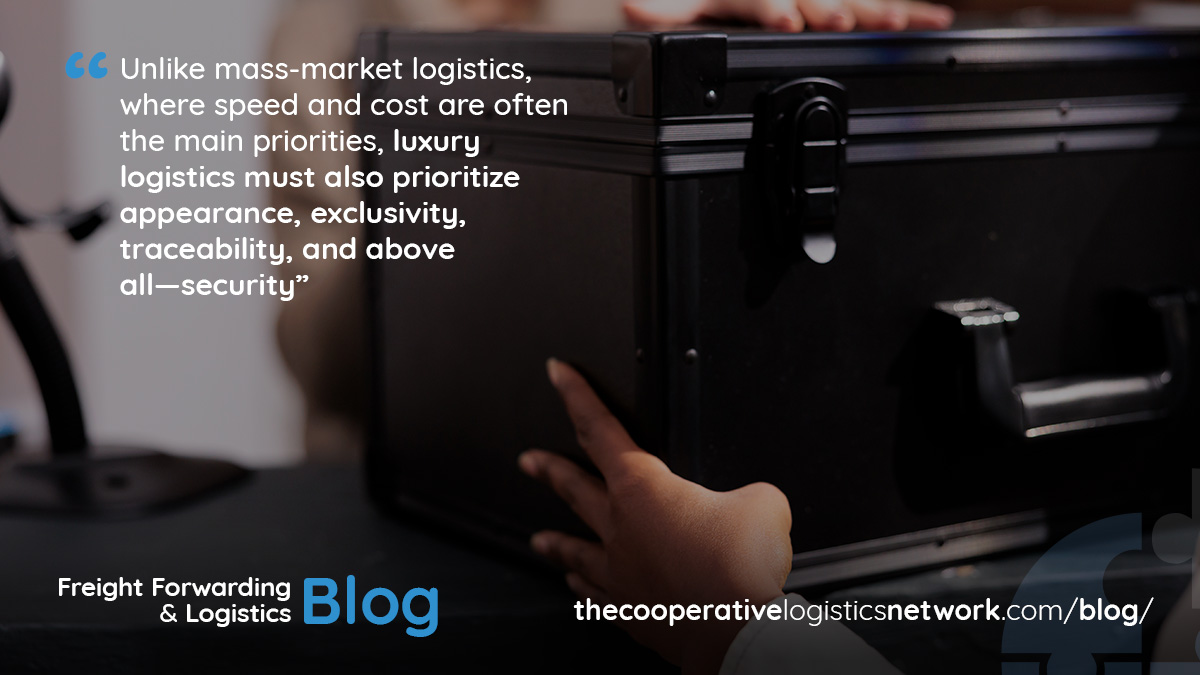For high fashion items such as rare gems, and exclusive brands, logistics isn’t just about transportation—it’s about trust, security, and precision. The movement of luxury items such as fine jewelry, couture fashion, and designer accessories requires a level of care and sophistication that goes far beyond standard freight forwarding. This is where luxury goods logistics comes into play: a highly specialized branch of logistics dedicated to the protection, discretion, and seamless delivery of high-value items.
As global luxury markets grow and consumer expectations evolve, freight forwarders are increasingly being called upon to handle these premium shipments with the white-glove treatment they demand. From secure warehousing and tamper-proof packaging to GPS-tracked vehicles and armed escorts, luxury goods logistics is a complex, high-stakes operation where the smallest error can translate to massive financial and reputational losses.
The rise of luxury goods logistics in the global marketplace
Global demand for luxury products is surging, especially in Asia, the Middle East, and North America. According to industry analysts,the luxury goods market is projected to reach US$495.16 billion in revenue by 2025, with an expected annual growth rate (CAGR) of 3.94% from 2025 to 2029. This growth is driven by millennials and Gen Z consumers who expect fast, flawless delivery experiences alongside their premium purchases.
With e-commerce and omnichannel retail strategies redefining how luxury products are sold, brands can no longer rely solely on boutique showrooms or flagship stores. Today’s high-end consumers are buying Cartier bracelets online and expecting them to arrive within 24 to 48 hours, securely packaged and insured. That’s where luxury goods logistics becomes a vital part of brand reputation and customer experience.
Unlike mass-market logistics, where speed and cost are often the main priorities, luxury logistics must also prioritize appearance, exclusivity, traceability, and above all—security.

Security: The cornerstone of luxury goods logistics
When transporting luxury items, security is not just a feature—it’s the foundation. Whether moving a million-dollar diamond necklace or limited-edition sneakers, the value of the cargo demands end-to-end protection.
Luxury goods logistics providers must incorporate a multi-layered security approach that includes armed personnel, real-time GPS tracking, surveillance, and biometric access at storage facilities. Every touchpoint in the supply chain must be documented, verified, and closely monitored to prevent theft, loss, or tampering.
Freight forwarders working in this segment often coordinate with law enforcement or use high-security courier partners for the most sensitive deliveries. Furthermore, contingency plans must be in place to address everything from customs seizures to political unrest in destination countries.
A key differentiator in this space is discretion. Labels, packaging, and documentation are often deliberately vague or coded to avoid drawing attention. In this way, the entire process is designed to remain invisible to all but the most essential handlers.
Handling, packaging, and climate control
Luxury goods aren’t just expensive—they’re delicate. Whether it’s a silk couture gown, a vintage Chanel bag, or a custom Rolex watch, the risk of damage during transport is high without specialized handling procedures.
Freight forwarders specializing in luxury goods logistics must ensure proper cushioning, climate-controlled environments, and anti-static or anti-tarnish materials during packing and transit. For example, exposure to heat or humidity can damage high-end leather goods or distort fine textiles, while poor vibration control can lead to cracks in gemstones or glassware.
Packaging must be both secure and elegant. Many brands require the use of branded boxes, signature wrapping, and even unboxing experiences that mirror the in-store luxury experience. Logistics partners must strike a fine balance between secure, tamper-proof materials and aesthetically pleasing packaging that reinforces the brand’s premium image.
Customs, insurance, and documentation
Transporting luxury goods internationally involves complex regulatory and documentation requirements. Customs declarations must be accurate, compliant, and complete—any discrepancy can lead to delays, fines, or confiscation.
Items such as animal-skin handbags or coral-based jewelry may require CITES certificates, while diamond shipments often come with Kimberley Process documentation. Each product category has its own regulatory framework, and freight forwarders need to be fully informed of international trade laws to avoid risks.
Moreover, no luxury shipment should ever travel uninsured. Logistics providers must work with specialist insurers who understand the nuances of high-value cargo, from liability during storage to coverage for rare or irreplaceable goods. Often, underwriters will require the logistics company to follow specific procedures and approved transportation routes as a condition of coverage.
E-Commerce and direct-to-consumer shipping for luxury brands
The growth of luxury e-commerce has changed how designer brands approach logistics. Direct-to-consumer (DTC) shipping now represents a major sales channel, especially for fashion houses looking to control the customer experience from start to finish.
Luxury goods logistics providers must be able to offer fast, flexible, and secure last-mile delivery services that uphold the brand’s values and image. This could include white-glove delivery personnel, branded delivery vans, or even appointment-based deliveries that align with the recipient’s schedule.
Furthermore, the demand for real-time updates has led many luxury brands to integrate digital freight forwarding platforms that provide shipment visibility to both internal teams and customers. This not only increases transparency but also builds customer confidence and loyalty.
The role of digital freight forwarding in luxury logistics
Technology is playing a transformative role in luxury goods logistics, allowing forwarders to offer better visibility, control, and risk management across the supply chain. With digital freight forwarding platforms, logistics teams can automate booking, monitor cargo in real time, and instantly share documentation with clients and customs authorities.
These tools are especially useful in luxury logistics where even minor delays or miscommunications can result in significant reputational damage. Platforms that allow for automated notifications, digital proofs of delivery, and integrated insurance verification are quickly becoming essential.
Moreover, digital freight forwarding solutions improve internal coordination among stakeholders—brands, warehouses, customs brokers, and insurers—ensuring that everyone is on the same page and that shipments stay on schedule.
Freight forwarding networks and the competitive edge they can provide
One of the key challenges in luxury goods logistics is finding reliable partners across the globe who can deliver the same level of service at every stage of the supply chain. This is where independent freight forwarders benefit greatly from belonging to global freight networks like The Cooperative Logistics Network.
Through its exclusive membership and emphasis on quality and cooperation, The Cooperative Logistics Network ensures that members have access to vetted logistics partners in over 260 cities worldwide. This creates a seamless and secure logistics pipeline for moving high-value goods across borders.
Additionally, tools like FreightViewer, The Cooperative’s online freight quote generation platform, allow members to digitize their quoting process and provide fast, accurate, and professional quotes for luxury shipments. This digital approach enhances credibility and helps members respond faster to the high-stakes needs of luxury clients. In the competitive world of digital freight forwarding, having access to technology, trust-based partnerships, and global coverage makes all the difference.
Conclusion
Luxury goods logistics is not just about moving cargo—it’s about preserving brand prestige, customer trust, and the delicate balance between speed and security. For freight forwarders entering or operating in this niche, success depends on precision, discretion, and the ability to deliver excellence at every touchpoint.
As global luxury markets continue to expand and digital channels become more dominant, logistics providers must evolve their services to match the expectations of both brands and their discerning clientele. With the right combination of specialized handling, advanced technology, and global collaboration, freight forwarders can position themselves as the invisible force behind the world’s most coveted products.


